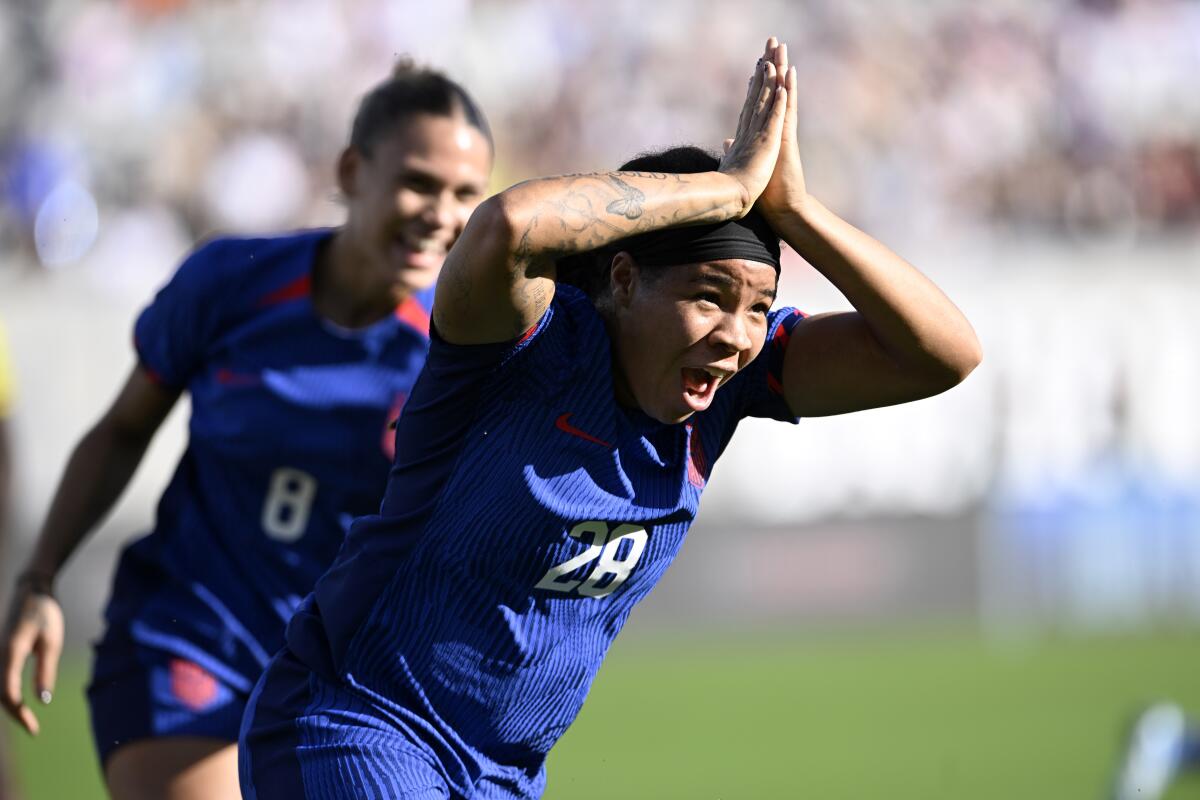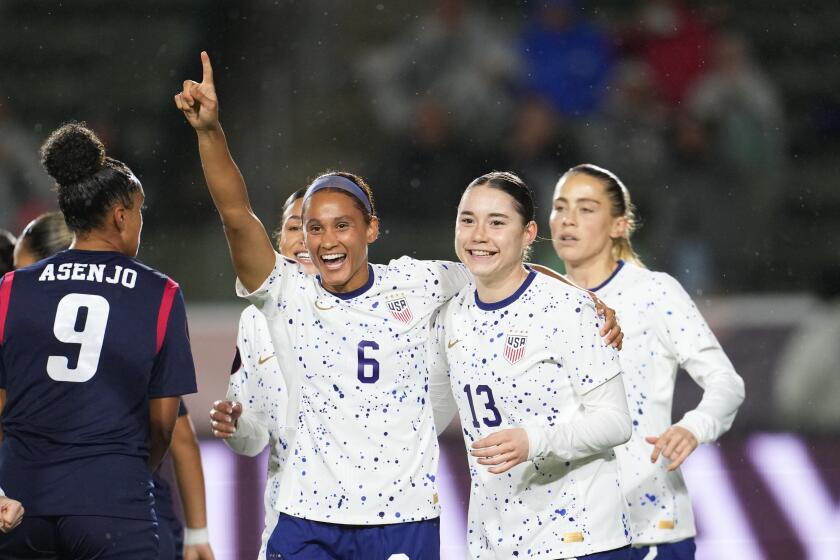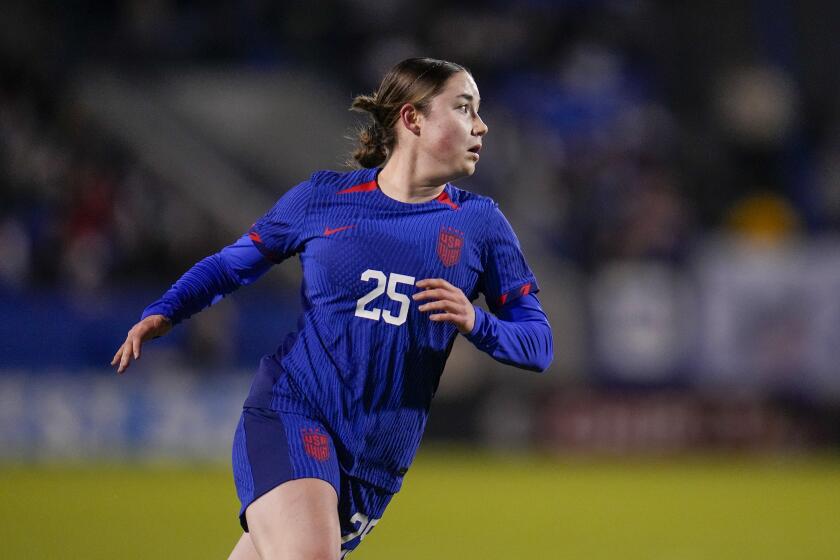Commentary: Mia Fishel’s ACL injury only the latest in disturbing trend in women’s soccer

Mia Fishel should have been in the starting lineup for the women’s national team Tuesday. Instead, she wasn’t even on the roster.
The first CONCACAF W Gold Cup was to be her coming-out party, the springboard that would catapult her into contention for a spot on the Olympic team this summer. Instead, she’ll be watching the Olympics from her sofa.
A future that seemed limitless for Fishel entering the week is now clouded in doubt after a freak accident during the final training session for Tuesday’s Gold Cup opener against the Dominican Republic, a game the U.S. won 5-0 behind two goals from teenager Olivia Moultrie before a crowd of 3,242 on a cold, rainy night at Dignity Health Sports Park. In the first game, Mexico outshot Argentina 16-3 but had to settle for a scoreless draw.
The tournament continues Friday in Carson with the second-ranked U.S. facing Argentina and Mexico playing the Dominican Republic. And it will go on without Fishel, who tore the ACL in right knee during a short practice on a rain-slicked field Monday afternoon.
“I’m gutted for Mia, and I know the team and the entire staff is as well,” interim U.S. coach Twila Kilgore said. “She’s been very effective in camp and has worked hard to make an impact.”
The U.S. women’s national team rolled to a 5-0 win over the Dominican Republic during its CONCACAF W Gold Cup opener in Carson Tuesday night.
Getting an opportunity to make that kind of impression with the national team has long eluded Fishel, who was called up just once and didn’t see the field under coach Vlatko Andonovski. Her call-up this month was her fourth since Andonovoski resigned and with Emma Hayes, Fishel’s coach at Chelsea, set to take over the USWNT this spring, things finally seemed to be breaking her way.
“I want to play on the U.S. national team. It’s a dream of mine,” said Fishel, whose uncles Andrew and David Bascome played internationally for Bermuda. “When I think what I’m doing on the field isn’t enough, it’s frustrating. But I continued to tell myself to stay patient, keep doing what you’re doing and it’s going to be undeniable at some point.”
Now all that’s been put on hold.
A U.S. Soccer spokesman declined to discuss details of the injury, though Kilgore said Tuesday that Fishel was hurt on a noncontact play with teammates around her. Not that those details would have mattered anyway.
The Guardian reported this week that over a recent 18-month period, more than 195 elite women players have been sidelined by ACL injuries, including Fishel’s Chelsea teammate Sam Kerr, who last month sustained her second ACL injury.
It’s become a scourge, the cause of which seems to defy both rhyme and reason. Players have torn their ACLs on wet fields and dry ones, on turf and grass, through contact and while practicing alone. When USWNT midfielder Kristie Mewis tore her left ACL in 2018, she said she was making a move she had made thousands of times in her career without incident.
That time it ended with her writhing on the ground in pain.
UEFA, European soccer’s governing body, put together a panel of experts in December in an effort to understand why women players are four to six times more likely than men to suffer from ACL injuries.
According to Dr. Mark Cullen, an orthopedic surgeon and sports medicine specialist in Portsmouth, N.H., 70% of ACL injuries in female soccer players are noncontact injuries that primarily involved one of two mechanisms: running and cutting sharply or landing on one leg that is in extension. Both mechanisms put significant strain on the ACL.
In addition, Cullen said, female soccer players are more likely to injure their nondominant leg while men tend to hurt their dominant leg.
Several theories have been offered for why that is, citing everything from a condensed match schedule, physiological differences between the genders and the way women run to a rising level of play in women’s soccer and even simple bad luck.
The number of elite players who haven’t torn their ACLs is seemingly smaller than the number who have. Megan Rapinoe tore her ACL three times. Alex Morgan ruptured hers in high school. So did NWSL teammate Jaedyn Shaw. Naomi Girma, U.S. Soccer’s female athlete of the year, tore hers in college.
None of that is likely to make Fishel feel better. After an MRI on Monday confirmed the tear, her parents drove up from San Diego to be with her that night, then drove her back to San Diego the next morning to await surgery, which will be followed by at least eight months of rehab, ruling her out of the Paris Olympics.
“I know she’ll come back strong,” Kilgore said.
There’s no way she can know that, of course. Christen Press, a two-time World Cup champion, tore the ACL in her right knee eight games into Angel City FC’s first season in 2022 and hasn’t played since. USWNT midfielder Catarina Macario tore her left ACL 21 months ago and only recently returned to training.
USWNT player Olivia Moultrie wasn’t trying to save U.S. women’s soccer as much as she was trying to jump-start a career with age-limit court case.
Macario was 22 when she was injured, the same age Fishel is now. But Macario already had played in 17 games for the USWNT, including in the Tokyo Olympics, and won a Champions League title with Lyon. That was what Fishel wanted when she left UCLA after three seasons and turned her back on the NWSL to play in Mexico’s Liga MX with Tigres.
It was a route no top American had taken before, but it paid off when Fishel scored 17 times in 17 games in the 2022 Apertura, becoming the first foreigner to lead the league in scoring. That earned her a three-year contract with Chelsea, the club she wanted to play with all along. That, in turn, led to this month’s call-up for the Gold Cup, where she was expected to play in a competitive match on the senior level for the first time.
“I’ve always said I want to be the best soccer player and that’s not going to happen if I’m comfortable and doing things that are easy,” she said last week. “Challenging myself is what makes me happy. If everything was the same — you know, same training, same way of life — it’s boring.
“You want something different to challenge you.”
The toughest challenge of Fishel’s career is just beginning.









